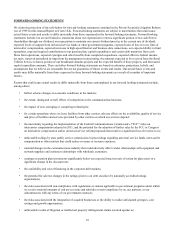Windstream 2012 Annual Report Download - page 76
Download and view the complete annual report
Please find page 76 of the 2012 Windstream annual report below. You can navigate through the pages in the report by either clicking on the pages listed below, or by using the keyword search tool below to find specific information within the annual report.14
If a disruption occurs in one of our data centers, our customers could lose access to information critical to running their
businesses, which could result in a loss of customers. We may also incur significant operating or capital expenditures to restore
service. As a result, disruptions could affect our results of operations and financial condition.
Increases in broadband usage may cause network capacity limitations, resulting in service disruptions or reduced capacity
for customers.
Video streaming services and peer-to-peer file sharing applications use significantly more bandwidth than traditional Internet
activity such as web browsing and email. As utilization rates and availability of these services continue to grow, our high-speed
Internet customers may use much more bandwidth than in the past. If this occurs, we could be required to make significant
capital expenditures to increase network capacity in order to avoid service disruptions or reduced capacity for customers.
Alternatively, we may choose to implement network management practices to reduce the network capacity available to
bandwith-intensive activities during certain times in market areas experiencing congestion, and these actions could negatively
affect customer experience and increase customer churn.
While we believe demand for these services may drive high-speed Internet customers to pay for faster broadband speeds, we
may not be able to recover the costs of the necessary network investments. This could result in an adverse impact to our results
of operations and financial condition.
We cannot assure you we will continue paying dividends at the current rate.
Our board of directors maintains a current dividend practice for the payment of quarterly cash dividends at a rate of $0.25 per
share of common stock. This practice can be changed at any time at the discretion of the board of directors, and our common
stockholders should be aware that they have no contractual or other legal right to dividends. In addition, the other risk factors
described in this section could materially reduce the cash available from operations or significantly increase our capital
expenditure requirements, and these outcomes could cause funds not to be available when needed in an amount sufficient to
support our current dividend practice.
The amount of dividends that we may distribute is also limited by restricted payment and leverage covenants in our credit
facilities and indentures, and, potentially, the terms of any future indebtedness that we may incur. The amount of dividends that
we may distribute is also subject to restrictions under Delaware law. If our board of directors were to adopt a change in our
current dividend practice that results in a reduction in the amount of dividends, such change could have a material and adverse
effect on the market price of our common stock.
We are subject to various forms of regulation from the Federal Communications Commission ("FCC") and state regulatory
commissions in the states in which we operate, which limit our pricing flexibility for regulated voice and high-speed Internet
products, subject us to service quality, service reporting and other obligations and expose us to the reduction of revenue
from changes to the universal service fund, the intercarrier compensation system, or access to interconnection with
competitors' facilities.
As of December 31, 2012, we had operating authority from each of the 48 states and the District of Columbia in which we
conducted local service operations, and we are subject to various forms of regulation from the regulatory commissions in each
of these areas as well as from the FCC. State regulatory commissions have jurisdiction over local and intrastate services
including, to some extent, the rates that we charge and service quality standards. The FCC has primary jurisdiction over
interstate services including the rates that we charge other telecommunications companies that use our network and other issues
related to interstate service. These regulations restrict our ability to adjust rates to reflect market conditions and affect our
ability to compete and respond to changing industry conditions.
Future revenues, costs, and capital investment in our wireline business could be adversely affected by material changes to or
decisions regarding applicability of government requirements, including, but not limited to, changes in rules governing
intercarrier compensation, state and federal USF support and other pricing and requirements. Federal and state communications
laws may be amended in the future, and other laws may affect our business. In addition, certain laws and regulations applicable
to us and our competitors may be, and have been, challenged in the courts and could be changed at any time. We cannot predict
future developments or changes to the regulatory environment or the impact such developments or changes would have.
In addition, these regulations could create significant compliance costs for us. Delays in obtaining certifications and regulatory
approvals could cause us to incur substantial legal and administrative expenses, and conditions imposed in connection with
























